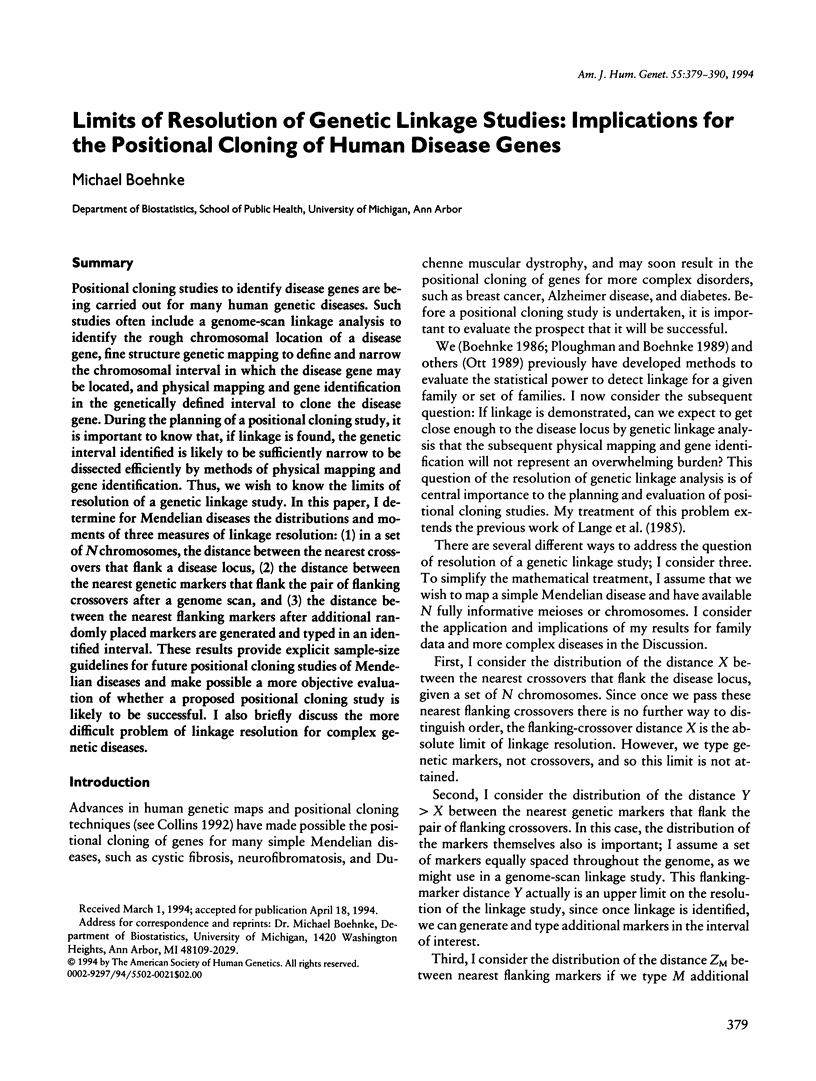Limits of resolution of genetic linkage studies: implications for the positional cloning of human disease genes (original) (raw)
. 1994 Aug;55(2):379–390.
Abstract
Positional cloning studies to identify disease genes are being carried out for many human genetic diseases. Such studies often include a genome-scan linkage analysis to identify the rough chromosomal location of a disease gene, fine structure genetic mapping to define and narrow the chromosomal interval in which the disease gene may be located, and physical mapping and gene identification in the genetically defined interval to clone the disease gene. During the planning of a positional cloning study, it is important to know that, if linkage is found, the genetic interval identified is likely to be sufficiently narrow to be dissected efficiently by methods of physical mapping and gene identification. Thus, we wish to know the limits of resolution of a genetic linkage study. In this paper, I determine for Mendelian diseases the distributions and moments of three measures of linkage resolution: (1) in a set of N chromosomes, the distance between the nearest crossovers that flank a disease locus, (2) the distance between the nearest genetic markers that flank the pair of flanking crossovers after a genome scan, and (3) the distance between the nearest flanking markers after additional randomly placed markers are generated and typed in an identified interval. These results provide explicit sample-size guidelines for future positional cloning studies of Mendelian diseases and make possible a more objective evaluation of whether a proposed positional cloning study is likely to be successful. I also briefly discuss the more difficult problem of linkage resolution for complex genetic diseases.

Selected References
These references are in PubMed. This may not be the complete list of references from this article.
- Bickmore W. A., Sumner A. T. Mammalian chromosome banding--an expression of genome organization. Trends Genet. 1989 May;5(5):144–148. doi: 10.1016/0168-9525(89)90055-3. [DOI] [PubMed] [Google Scholar]
- Boehnke M. Estimating the power of a proposed linkage study: a practical computer simulation approach. Am J Hum Genet. 1986 Oct;39(4):513–527. [PMC free article] [PubMed] [Google Scholar]
- Edwards J. H. The analysis of X-linkage. Ann Hum Genet. 1971 Feb;34(3):229–250. doi: 10.1111/j.1469-1809.1971.tb00237.x. [DOI] [PubMed] [Google Scholar]
- Lange K., Kunkel L., Aldridge J., Latt S. A. Accurate and superaccurate gene mapping. Am J Hum Genet. 1985 Sep;37(5):853–867. [PMC free article] [PubMed] [Google Scholar]
- Morton N. E. Parameters of the human genome. Proc Natl Acad Sci U S A. 1991 Sep 1;88(17):7474–7476. doi: 10.1073/pnas.88.17.7474. [DOI] [PMC free article] [PubMed] [Google Scholar]
- Ott J. Computer-simulation methods in human linkage analysis. Proc Natl Acad Sci U S A. 1989 Jun;86(11):4175–4178. doi: 10.1073/pnas.86.11.4175. [DOI] [PMC free article] [PubMed] [Google Scholar]
- Ploughman L. M., Boehnke M. Estimating the power of a proposed linkage study for a complex genetic trait. Am J Hum Genet. 1989 Apr;44(4):543–551. [PMC free article] [PubMed] [Google Scholar]
- Saccone S., De Sario A., Della Valle G., Bernardi G. The highest gene concentrations in the human genome are in telomeric bands of metaphase chromosomes. Proc Natl Acad Sci U S A. 1992 Jun 1;89(11):4913–4917. doi: 10.1073/pnas.89.11.4913. [DOI] [PMC free article] [PubMed] [Google Scholar]